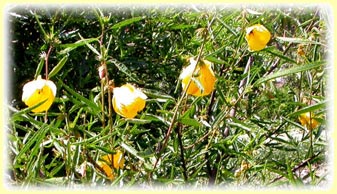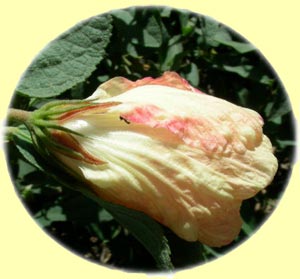 |
| Search this site: |
Hibiscus Section Furcaria: Crosses, To Be or Not To Be
Written for the Association of Societies for Growing Australian Plants, Hibiscus and Related Genera Study Group.
It is now well over fifty years since I was captivated by my favourite native hibiscus, Hibiscus heterophyllus. My interest in this species has continued, particularly as I have watched locally occurring plants flowering profusely for prolonged periods, in spite of the extended drought condition in Brisbane over recent years. I have given plants to friends in both Melbourne and Cairns and the plants perform well in both these locations. Hibiscus heterophyllus was recorded in the Brisbane area in 1824 by Allan Cunningham, in 1828 by Charles Fraser and again in 1844 by Ludwig Leichhardt. Describing the vegetation along the Brisbane River, Cunningham noted that Hibiscus heterophyllus was very frequent on the immediate bank "clothed with a profusion" of flowers. This tough, showy, rainforest plant is a member of Hibiscus Section Furcaria. Hibiscus Section Furcaria is perhaps best known for Hibiscus sabdariffa, Rosella, an introduced hibiscus. Other overseas members of this section include Hibiscus acetosella, Red Shield Hibiscus and Hibiscus radiatus. Hopefully, the Australian members of this section will be increasingly recognised for their hardiness and usefulness.
EARLY EXPERIENCES OF HIBISCUS CROSSESI still recall my first glimpses of the large white flowers of Hibiscus heterophyllus (W1) that lit up the edges of the rainforest as we negotiated precarious tracks on steep hillsides on the south coast of New South Wales. Having loved Hibiscus heterophyllus for so long, this was one of the very first plants we tried to acquire when establishing a garden in Brisbane in 1975. However, before I was able to obtain a plant of Hibiscus heterophyllus, a friend with a nursery begged me to take home a plant labelled Hibiscus divaricatus x H. splendens, (W2, W3) mainly because it was outgrowing its pot. Initially it was the only native hibiscus in our garden and looked just like Hibiscus divaricatus, with the shiny green foliage, gold blooms and growth typical of this species.

Hibiscus divaricatus x Hibiscus splendens
In the late 1970s, a seedling appeared underneath this hibiscus. To our amazement, the seedling had grey foliage and pale apricot blooms which were larger than the blooms of the parent. We realized that the label on the parent plant was accurate, in spite of its similarity to its pod parent. It really was a cross as the seedlings had characteristics of the pollen parent, Hibiscus splendens. The attached photos show blooms and foliage similar to the blooms and foliage of our first seedling. This was our first experience of hibiscus hybrids.
 |
 |
| Seedling of Hibiscus divaricatus x Hibiscus splendens showing features of Hibiscus splendens. | |
Our second experience of hibiscus hybridisation took place when we moved to a larger garden in 1981. Our bush block was near an endemic stand of Hibiscus heterophyllus. By then, we had managed to acquire a plant of the gold-flowering form of Hibiscus divaricatus. To our horror, the patch of nearby white H. heterophyllus began to include bushes with lemon blooms. The plants were almost 200 metres away but this was not too far for whatever had pollinated these plants with pollen from our Hibiscus divaricatus. Fortunately the lemon “H. heterophyllus” were cleared for housing so they did not contaminate other locally occurring stands of native hibiscus.
These experiences taught us some of our early lessons with crosses in Section Furcaria.
- Seedlings may have characteristics that are quite different and possibly, although not necessarily, superior to characteristics of the parents.
- Native hibiscus cross readily and crosses near stands of bush with endemic species may have unforeseen and unwelcome consequences.
Just how readily plants in this section of hibiscus cross was highlighted when I planted seed of a one metre annual form of Hibiscus meraukensis. The resulting seedling was a 3 metre perennial with lemon blooms. Again the pollinator was Hibiscus divaricatus. This seedling has been named Hibiscus ‘Ian’s Lemon’ in memory of Ian Waldron.

FAQs | Links | Contact Us | Privacy Policy
Copyright © 2000-2011 hibiscus.org All rights reserved.
Featuring a selection of classic hymns performed on piano and organ, with lyrics, free for reuse